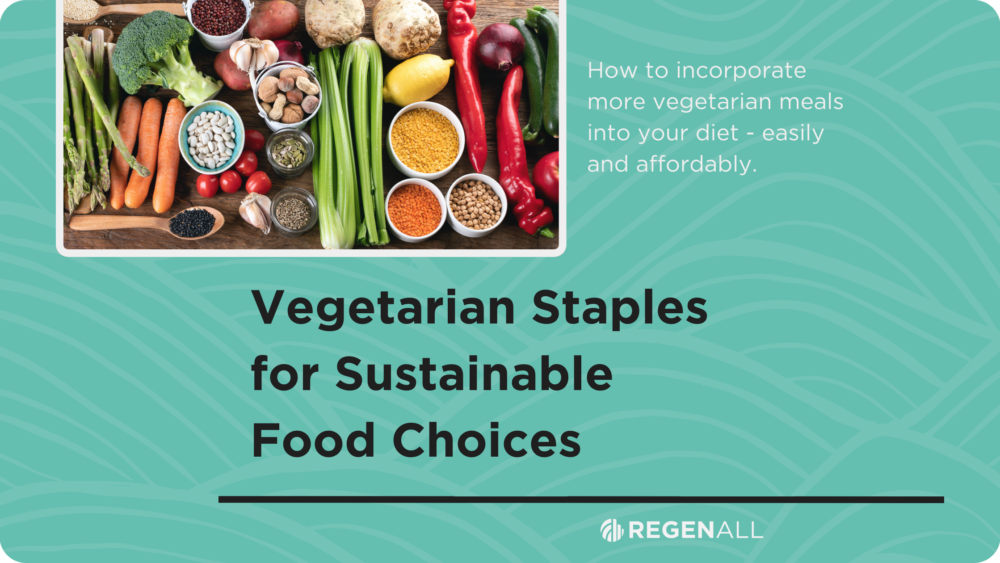Limiting your consumption of animal products, particularly meat, is one of several places to start when looking for ways to reduce your carbon footprint. Livestock produces methane, a greenhouse gas that traps heat better than carbon dioxide but that, luckily, also exits the atmosphere more quickly. This means that a plant-based diet can punch outside its weight class in the fight against climate change.
If you are curious about trying a meat-free diet, or even just interested in limiting the amount of meat you consume, options abound. There are plant-based meat alternatives out there for everything from hamburgers to sausage to bacon, and more choices hit the market every day. Meanwhile, talented vegan and vegetarian chefs continue to innovate, creating Insta-worthy treats that entice even the most dedicated of carnivores.
All this choice is awesome—but it can be overwhelming. Sometimes, it’s best to keep things simple. So—hi. I’ve been vegetarian all my life. I am cheap, lazy, don’t really like cooking, and go grocery shopping as rarely as I think I can get away with. And these are my meat-free staples:
Beans
Obviously the star of vegetarian chili or taco night, but don’t stop there! Beans are delicious in a soup, tossed into pasta, or used to top salad. Black beans are my go-to for chili (although mixing a few varieties together keeps things interesting), but white beans such as cannellini can’t be beat for their versatility. In the summer, a three-bean salad or bean-and-pasta salad is a light, meal-preppable lunch. In the winter, I like to make soup with canned pureed pumpkin, white beans, and a leafy green, plus plenty of herbs and whatever vegetables I have lying around.
Red Lentils
Lentils are a great source of iron and protein, and like beans, are great for bulking out a meal. All lentils are delicious, but when I cook, I use red for one crucial reason: they cook much faster, about as fast as pasta. Unlike other varieties, red lentils do not retain their shape as they cook, making them perfect for soup. Just dump in about half a cup to a cup. As the lentils break down, they produce a creamy, hearty broth that goes beautifully with whatever spices you throw in.
Your local supermarket may or may not have red lentils, but you can find them in bulk at any Indian grocery, or online.
Peanuts and Peanut Butter
Growing up, my brother and I needed portable, easy-to-make, vegetarian food for our school lunches. We also preferred to pack food that wouldn’t get us bullied (eating anything unusual in a school cafeteria is risky business.) Anyway, peanut butter and jelly sandwiches were one of my primary food groups throughout primary and secondary school. After college, living on a challengingly small stipend, peanut butter sandwiches once again came to the rescue. So they hold a dear place in my heart.
These days, my grocery budget is a little bigger, but I keep my old friends on standby. I have unsalted peanuts in my house at all times, usually multiple canisters of them, and I put them in more than you might think. I love them in salads, or sprinkled over a stir fry. I also eat them out of the can, obviously, or mixed into trail mix. Peanut butter, as well as being delicious on apples, can be used to add heft and flavor to recipes, such as it is in Ghanaian peanut soup. I also just like it on bread with chocolate (this is not a health blog.)
If you don’t like, or can’t eat, peanuts, there are many other nuts and seeds out there, and hopefully there’s one for you!
Flavorings
In general, you should use whatever spices you usually like, taste as you cook, experiment, and figure out what works for you. However, you might want to pay extra attention to things with a smoky or umami flavor, as these flavors are less common (thought certainly existent) in vegetables.
For a smoky flavor, you can try liquid smoke or smoked paprika. There are many options for umami flavorings, including soy sauce, sharp cheese, and tomato paste. My favorite is miso, a fermented soy product that you can get at any Asian grocer. It lasts for ages in the fridge, and tastes great as a soup base or mixed into pasta sauce.
Nothing interesting to say about these but: here are some additional foods that I always have in my house: pasta, bread, rice, canned tomatoes, onions, peppers, olives, oatmeal, raisins, apples, breadcrumbs, canned soups, cheese and eggs (never said I was vegan), the usual assortment of herbs, spices, condiments, etc.
Finally: If your goal is simply to reduce the amount of meat you’re eating, and not to eliminate it from your diet completely, and you want to cook your collard greens in bacon grease or slip a little fish sauce into a curry, I’m not here to judge you! The goal is to eat a diet that is sustainable for the planet. But for that to work, it also needs to be sustainable for you. That means finding ways to eat vegetables that you really enjoy, even if a little bit of meat gets involved.



Comments are closed.